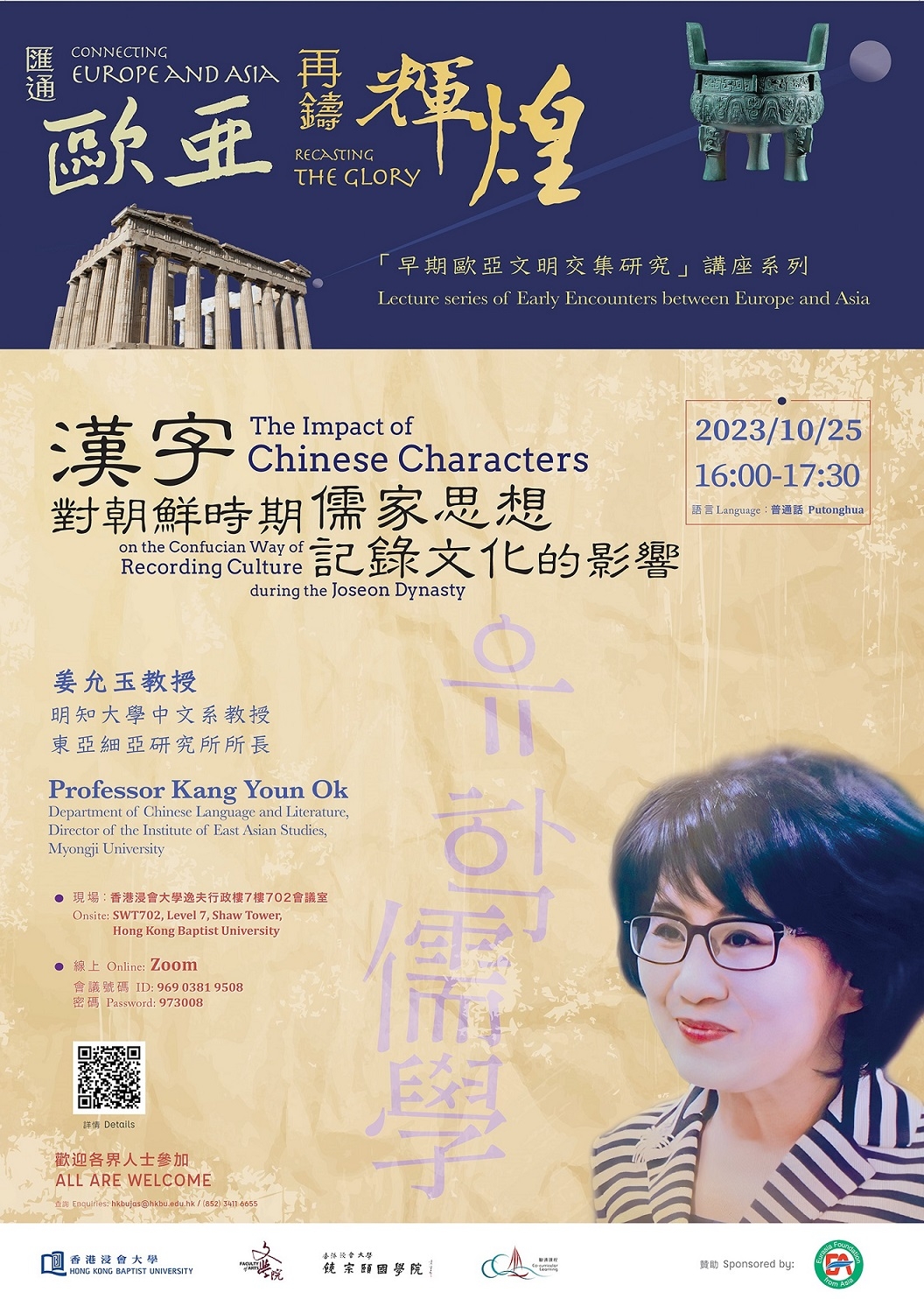
Connecting Europe and Asia, Recasting the Glory: Lecture series of Early Encounters between Europe and Asia
Lecture 5: The Impact of Chinese Characters on the Confucian Way of Recording Culture during the Joseon Dynasty
2023/10/25 │ 16:00–17:30
Professor Kang Youn Ok
Department of Chinese Language and Literature,
Director of the Institute of East Asian Studies,
Myongji University
- Abstract: The culture of the Han Chinese, also called ‘Huaxia culture’ or ‘Chinese culture’, is rich and varied and a culture of great importance that was created by ancestors of the Chinese people through long-term production and practical implementation in society. During the long epoch prior to more recent times, culture of this type was the most advanced in the world, and it generated a strong radiation that exerted influence on the surrounding countries and territories, especially the East Asian nations of Korea and Japan, and even the states of South-east Asia, including Vietnam.
Not only was Korea the first state in the world to import Chinese characters and Confucian culture, but to some extent, its veneration of Confucian culture was even stronger than in China where the thought system was born. The influence and manifestation of Confucianism was thus especially evident in East Asian Korea. This lecture will principally discuss ‘the transmission of Chinese characters and Confucian thought’ and ‘the influence of Chinese characters on the Confucian record-keeping culture of the Joseon period’.
- Language: Putonghua
- Summary (Recorded by Guan Jinglin)
Professor Kang Youn Ok, Director of the Institute of East Asian Studies and Professor at the Department of Chinese Language and Literature at Myongji University, gave a lecture to us titled: ‘The Impact of Chinese Characters on the Confucian Way of Recording Culture during the Joseon Dynasty’.
In this lecture, Professor Kang first introduced the process by which Chinese characters were transmitted into the Korean peninsula. According to her research into excavated documents, in terms of form and manufacture, contents, and calligraphic style, the writings on bamboo slips unearthed in 1990–1992 in Pyongyang resemble closely those on the Han dynasty slips of Dingzhou. From this it is seen that as early as approximately the Western Han emperor Wudi of the first century BCE, Confucian classics written in Chinese characters on wooden and bamboo slips as their medium of transmission had penetrated the Korean peninsula. Subsequently in the unification of the Silla era and the Goryeo era, Chinese characters gradually disseminated and were widely used in the higher echelons of society, and in the Joseon era (thirteenth–eighteenth centuries), they were absorbed into the daily life of the common people.
Following on from this, Professor Kang focused her discussion on the impact of Chinese characters on the Confucian way of recording culture during the Joseon era. Confucian thought was the state religion of Korea. During the Joseon era, Chinese characters were used to record from several angles the historical heritage of the Confucian societal system. This process included printing texts embodying Confucian thought as ‘Confucian editions’ and issuing official national documents such as Joseon Wangjo sillok (Veritable records of the Joseon dynasty) and Gugjo o lyeui (The Five Rites and Ceremonies of the royal court) as well as the vernacular documentary record of that which Chinese Confucian students saw and heard that is called Piaohai lu (Pyohaelog, Records of floating on the sea).
‘Confucian editions’ have been listed as items of cultural heritage of worldwide importance, and their principal theme is implementing the universality of human ethics as advocated by Confucianism. They are a fledgling text communication that, through books, opened channels between Confucian students and Confucian thought. As official national documents recording the implementation of the cultural system of Confucian thought, they are of great importance to research into the royal house, the rites and ceremonies, and the study of music. Piaohai lu portrays a vivid image of Ming dynasty political and economic life and its society and has great scholarly value in respect of research into Chinese history of the Ming dynasty and the dialects of North and South China. Through comparison of six different editions of Piaohai lu and vernacular Chinese characters of Chinese localities, Professor Kang has explored the usage of Chinese characters and the situation regarding the ebb and flow of textual variation.
Finally, Professor Kang talked about issues related to education in Chinese characters in South Korea. She advocates the parallel usage of the Korean alphabet and Chinese characters, the better, in this way, to imbibe Confucian thought. This itself is also an embodiment of maintaining peace and stability between those regions that retain the principles of Confucian culture.
- Lecture video
HKBUTube
This lecture series is sponsored by Eurasia Foundation (from Asia).